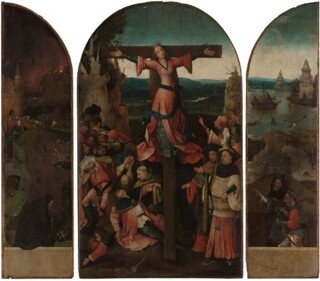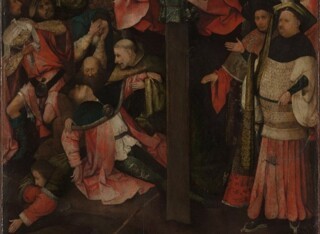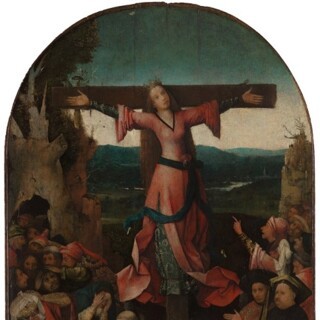A Whisper of a Beard
Mary Wellesley · St Uncumber’s Patch
Hieronymus Bosch painted clog ships, fish soldiers, armoured creatures with insect wings and scales gobbling human limbs. In the recesses of his paintings you might find a spoonbill, wearing a hooded cape, sitting down to a supper of bird-claw at a table set with white linen and pewterware. His picture of Saint Wilgefortis – usually in the Accademia in Venice, but currently on display atan exhibition in ’s-Hertogenbosch, the town where he lived and worked – is perhaps one of his least strange paintings. It shows a bearded woman being crucified.
Images of Wilgefortis were common in late medieval Europe. A picture of the saint used to hang above one of the altars in St John’s church in ’s-Hertogenbosch. There’s also a sculpture of her in the Henry VII chapel in Westminster Abbey. She looks demurely downwards, her eyes on a book. She has long, flowing hair and is wearing a crown. From her chin sprouts a thick and unmistakable beard. She is known as Uncumber in England (and elsewhere as Ontkommer, Kümmernis or Liberata). The name comes from the Latin combrus, meaning barricade or obstacle (as in cumbersome). Believed to unencumber her devotees, she is the patron saint of women with abusive husbands.
Her story has several variants, but most agree that she was the daughter of a pagan king of Portugal. Her father wanted her to marry the king of Sicily. Having taken a vow of virginity, she refused. She prayed to be made so unattractive that no one would want to marry her, and was rewarded with a beard. (Similar stories are told about other female saints. It was said that when St Brigid prayed for a deformity to save her from a marriage proposal, ‘one of her eyes burst and liquefied in her head.’) Wilgefortis’s suitor withdrew his offer, so her father did the fatherly thing and had her crucified.
The origins of Uncumber’s cult are unclear, but it seems she was a medieval invention. She appears in the ninth-century Martyrology of Usuardus. There are similarities between her story and that of a bearded nun named Galla, discussed by Gregory the Great in his Dialogues. In 1906, Hippolyte Delehaye, a Bollandist scholar, suggested that the image of Uncumber was a result of iconographic mangling. In particular he pointed to a wooden sculpture of a robed Christ, the Volto Santo in Lucca, a site of pilgrimage in the Middle Ages. Delehaye argued that the robed image of Christ was copied and recopied, in icons and pilgrim’s badges, and slowly morphed into a bearded woman on the cross.
Modern critics have proposed alternative origins for the cult, noting that hirsutism can be a consequence of anorexia nervosa. I prefer the Bollandist theory, however. Otherwise Uncumber is a painfully tragic figure: a girl who does not eat, crucified by her own father.
Many of Bosch’s pictures confirm Auden’s observation that suffering in Old Masters’ paintings ‘takes place/While someone else is eating or opening a window or just/walking dully along’. There are countless figures oblivious to other people’s agony. In the background of his painting of Saint Christopher, someone is hanging a bear from a tree. But in the picture of Uncumber, no one in the crowd at the foot of the cross is unaware on the fate of the beautiful girl in the outlandish dress, with a whisper of beard. Nobody here is just walking dully along. To the left of the cross, a man seems to have fainted from grief; others avert their eyes in horror. To the right, a figure who appears to be her father – fat and defiant – gestures towards the cross as if instructing people to look. Everyone in this press seems to be male.
Uncumber, by contrast, gazes heavenward. No human passion afflicts her. Her auburn hair is long, she wears a crown, and her red dress, which hugs her shapely form, billows decoratively above the heads of the people below. The picture is a reminder that some of the strangeness of Bosch is the strangeness of his world – a world in which the image of a bearded girl being crucified couldbecome an object of veneration.
Read more in the London Review of Books
Hilary Mantel on the Hair Shirt Sisterhood · 4 March 2004
Barbara Newman: Why can the dead do such great things? · 7 May 2015



Comments
I notice, too, that Wilgefortis' brocade undergown is securely tied around her cross under her feet - presumably to prevent any of the spectators from peeking to confirm what kind of undercarriage a person with breasts and a beard might have.